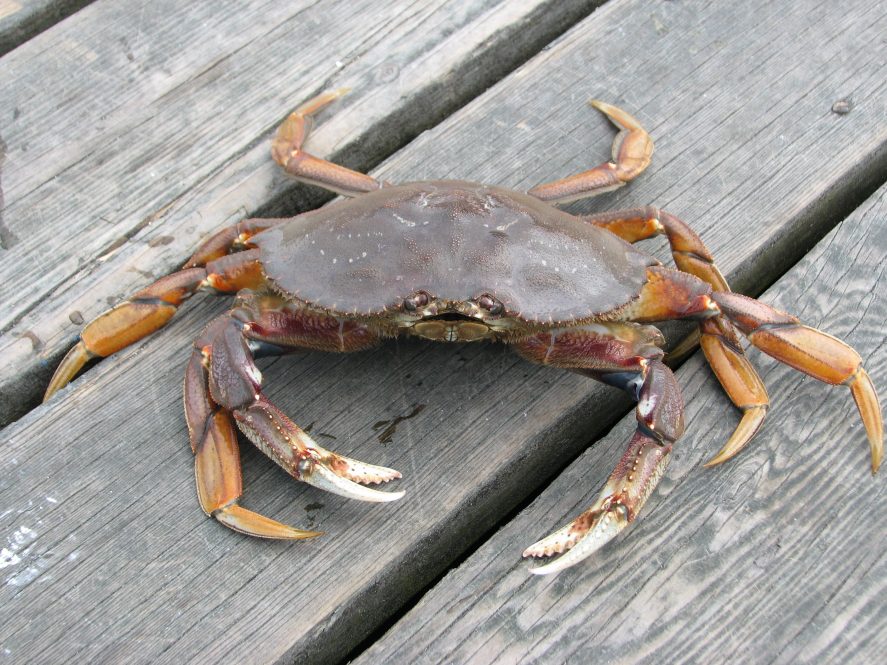For many marine animals, like the Dungeness crab, seasonality and timing are components of complex life cycles, where disruptions can have serious implications for the population. Understanding how climate change will impact each life stage is no small undertaking when considering all variables and moving parts in a changing environment. Despite these challenges, this information is vital for sustainable fishery management and to inform new conservation strategies.
A team of researchers from the University of Washington, the National Oceanic and Atmospheric Administration (NOAA), Simon Fraser University, and the University of Connecticut Department of Marine Science including Ph.D. student Halle Berger, Assistant Professor Catherine Matassa, and Assistant Professor Samantha Siedlecki, looked at the Pacific Northwest portion of the Dungeness crab fishery, which spans from Alaska down to Southern California. In a paper published this week in AGU Advances, they determined which life stages are most vulnerable, and to which stressors.
This research is part of a regional vulnerability assessment and collaboration funded by the NOAA Ocean Acidification Program. It also investigates environmental justice issues, says Siedlecki,
“Tribal communities in the Pacific Northwest identify Dungeness as both culturally and economically important species for their way of life. Species are moving but of course tribal communities don’t have the option of moving their land in response. The tribal communities are very interested and motivated to think about ways they can sustain the fishery.”
This assessment looked at three stressors all resulting from future carbon emissions: ocean acidification (OA), low oxygen levels (hypoxia), and warming temperatures. Berger explains that they integrated several layers of information to create a realistic model to study the consequences of stressors at different times throughout the life stages, from eggs, to larvae, to juveniles, to adults.
When modelling for future conditions, the Intergovernmental Panel on Climate Change (IPCC) has representative carbon pathways (RCP) that are emission scenarios considering differing degrees of carbon emissions mitigation.
“We used RCP 8.5, which is the highest, and considered the ‘worst case scenario’ if there is no climate change mitigation at all,” says Berger. “Then we overlaid the ocean conditions and habitat maps for each life stage. We also added something new to the framework, where we layered in a larval transport model to simulate the movement of larvae in the water column to get a more realistic picture of the conditions they would experience.”
Next, the researchers reviewed data from prior studies on Dungeness crabs, which helped them assign scores for vulnerability at each life stage to understand responses to the stressors on a more individual level. They did a weighted mean to estimate vulnerability at the population level, which Berger says factors in which life stage contributes the most to growth or vulnerability of the population.
“It turned out that the adult life stage is the most critical in driving the overall population vulnerability,” Berger says. “We found that for all three stressors there will be increased population level vulnerability in the future, and the most severe is to hypoxia. Low oxygen events are confined to the upwelling season, in spring and summer which impacts the adults, whereas ocean acidification manifests more year-round in the future, impacting all life stages.”
The researchers say these data could be easily incorporated into decision making processes to protect the vital life stages in particularly stressful conditions to help maintain sustainable fisheries.
“An example would be monitoring low oxygen events in the summer, and maybe pulling the crab traps earlier,” says Berger. “This would help mitigate from the crabs dying in the trap.”
By implementing these measures, fisheries would be protecting the adults, the most vulnerable and vital life stage for maintaining the population.
Berger points out that this study highlights the importance of looking at species vulnerability with a similar approach.
“This study showcases a lot about the importance of seasonality and life history complexity in this framework. Other vulnerability assessments that are looking at marine species that have complex life histories could also use this type of framework to capture some of those losses. The laboratory experiments that have been done were only able to look at each of these stressors independently but obviously they will all happen together. It is important that there are experiments that look at multi-stressor impacts to more accurately assess the overall, cumulative vulnerability.”
Animation of particles with intermediate behavior released within the Olympic Coast National Marine Sanctuary in Washington during April in the present and future. Particles are colored by dissolved oxygen, with the stress threshold (1.4 ml/l) highlighted in yellow. The motion design was created by Maria Raykova and Hongju Lim in the Scientific Visualization Course taught by Professor Anna Lindemann at the University of Connecticut.



